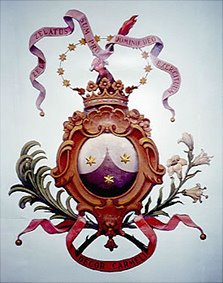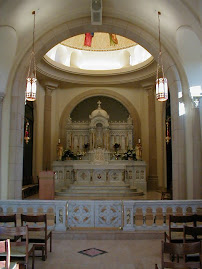 Be of good comfort, my children; cry to the Lord and He will deliver you - (Bar 4:21).
Be of good comfort, my children; cry to the Lord and He will deliver you - (Bar 4:21).
My delicate ones have walked rough ways (Bar 4:26)
Be of good comfort, my children...for as the neighbours of Sion have now seen your captivity from God, so shall they also shortly see your salvation from God, which shall come upon you with great honour and everlasting glory.
My children, suffer patiently the wrath that is come upon you...for He that hath brought evils upon you shall bring everlasting joy again with your salvation (Bar 4:21, 24, 25, 29)
We shall have afflictions, and for that reason this land of exile is termed a valley of tears. The happiest and most light-hearted will sooner or later have trouble and care. Oftentimes those who seem to have the least to bear have the most, for ti is not always external trials that weigh the heaviest on the heart. And we often have to endure our sufferings in silence for want of any one who can enter into and understand them; for to speak of them to unsympathetic ears only adds to the poignancy of our grief. In such straits where shall we turn if not to her who is the consoler of the afflicted? Whatever may be the cause of our sorrows, it will not be beneath her notice, for our Mother's heart is above all, a compassionate one. She has suffered too much herself not to sympathize with the sufferings of others. Her own heart was pierced with a sword that out of many hearts thoughts might be revealed. We are too inclined perhaps to lock up our afflictions within ourselves in a hopeless, perchance ever bitter or stoical way. Let us go to Mary and reveal to her all that is in our hearts, telling her our troubles in a simple, childlike way, and through the rent made by the cruel sword place them in hers. It is large enough for them all, for great as the sea was her affliction. Our trials may come from others - we may be ill-treated, wronged, misunderstood; or from fortune - poverty and want may be our share; or from ourselves - oftentimes our own character, tempers, humours, are our greatest affliction; or again they may come to us through the sorrows of those we love. Be they what they may, tell them to Mary; but surely, if they be one more than another that she can sympathize with, it will ne this last. WAs it not compassion for the sorrows of her Son that pierced her heart? Let her be our refuge in grief. Let us say with the wise man: "I took her to live with me, knowing she would be a comfort in my cares and griefs". Our Lady will not only listen to us, though with the utmost gentleness, that what seems a misfortune is in reality a blessing. If we have lost riches, she will let us see they might proved a snare to our soul. If a friend is taken from us by death, she will whisper that Jesus covets the place in our hearts which that friend once occupied. If ill-health be our lot, she will lead us to recognize that it cuts us off from many dangerous pleasures and amusements; and in this way we shall become so consoled by her that we may end by positively rejoicing over those things which caused our tears. But there is one grief, Mother mine, which even thou must find difficult to assuage. How comfort those who mourn and weep that Jesus, their beloved, is hated without cause? useless to bid them cease, for who could do so when the dearest of all who are dear to them is being mocked, ridiculed, driven from the hearts of men, nay, even crucified afresh, and that not once, but as many times as there are mortal sins committed in a day? Yet even in this, the grief of griefs, she can whisper words of consolation, even amidst her own tears - for did not her seven swords of sorrow spring from the same source , and did she not realize this more than all the lovers of Jesus put together? - and remind such souls that He had said: "Blessed are they that mourn, for they shall be comforted." For one day they will see that all these things will in the end redound to His greater glory, as showing forth the unspeakable love of that Sacred Heart which, knowing what was before Him and all that would come upon Him, with full deliberation left His heavenly home and braved it all for the sake of rescuing from eternal misery those who were willing to listen to His voice and yield Him their hearts. Our heavenly Mother will teach such souls that, while mourning that he is hated without cause, they can also, at the same time, rejoice in the thought that He is infinitely good. But there is yet another realm than earth where mary exercises her power as comforter of the afflicted, and that is in purgatory. Oh, how those poor prisoners must welcome the sight of their august Queen, when from time to time she visits them, bringing consolation and renewed hope in her train! And what can she say to ease these sufferings, the greatest of which must be that of seeing how we have wasted our substance - the many graces bestowed on us - and disappointed the Sacred Heart by not attaining to that perfection and to that degree of glory which He had planned for us, and for which he gave us the means? Well, she can comfort them by putting before them that at any rate their present sufferings will make at least some atonement for the past, and thus they will learn even to love those grievous torments;
 while those whose chief pain consists in the sense of loss will be joined to the happy throngs awaiting them in the heavenly kingdom. "Be of good comfort, my children... for as the nrighbours of Sion [your eternal home] have now seen your captivity from God, so shall they also see your salvation from God which shall come upon you with great honour and everlasting glory." (Bar 4) But Mary will have more than words to offer these suffering exiles. Can we think she will ever visit them without bringing a royal pardon for many of their number who will follow joyously in her train, speeding aloft towards Him whom they love and to whom their being craves to be united? And cannot we share in great measure our Mother's office of "Consolatrix Afflictorum"? Surely yes. Let us put self aside and enter lovingly into the sorrows of those around us, consoling, comforting and sympathizing with every form of suffering, no matter whence its source. Be it they have brought ot on their own heads, that is no reason for hardening our hearts. Self-condemnation is one of the bitterest forms of trial; let us not add to it by our censoriousness. Who has appointed us to judge over them? Then again for the souls in purgatory we can do most real work. Has not holy Church placed in our hands the means of paying their debts, giving us the key of the treasury of the Precious Blood, which on easy conditions we can sprinkle broadcast into the fierce flames, assuaging their heat and releasing their prisoners? Here indeed we can be co-operators with our Mother Mary. Not a day passes but we can put a treasure into her hands with which to ransom those beloved ones to God, many of whom we may have knnown in life, and who must often wonder at our not exerting ourselves more to obtain their release. Could time be better spent than freeing these holy prisoners who will bring immediate glory to God by their praise of Him and who will surely in their turn not forget us, but will plead our cause before "the great white throne", when our time comes to pay the penalty of our neglect of grace? Finally, before leaving our Mother Mary, whom we have been considering under so sweet and consoling an aspect as that of a universal consoler, let us call to mind that she was privilaged to be th comforter of God Himself. Did she not share the griefs of her divine Son, the Man of Sorrows, and by her deep sympathy bring consolation to His Sacred Heart, from Its first pangs of disappointed love in the cave at Bethlehem, when It realized that the creatures for whom He was preapred to do so much cared naught for Him, to Its last sigh on the cross they had prepared for Him? And how she longs for us to imitate her in this loving compassion for the Sacred Heart! "Comfort Him, all you who are round about Him", she whispers; and Jesus, when He sees us approach Him, more full of His griefs and wrongs than our own, will recognize us as true children of Mary, and virtue will go out from Him into our souls, and we shall become more truly His friends than we have hitherto been, for in times of common sorrow hearts become knit together by strong and lasting ties.
while those whose chief pain consists in the sense of loss will be joined to the happy throngs awaiting them in the heavenly kingdom. "Be of good comfort, my children... for as the nrighbours of Sion [your eternal home] have now seen your captivity from God, so shall they also see your salvation from God which shall come upon you with great honour and everlasting glory." (Bar 4) But Mary will have more than words to offer these suffering exiles. Can we think she will ever visit them without bringing a royal pardon for many of their number who will follow joyously in her train, speeding aloft towards Him whom they love and to whom their being craves to be united? And cannot we share in great measure our Mother's office of "Consolatrix Afflictorum"? Surely yes. Let us put self aside and enter lovingly into the sorrows of those around us, consoling, comforting and sympathizing with every form of suffering, no matter whence its source. Be it they have brought ot on their own heads, that is no reason for hardening our hearts. Self-condemnation is one of the bitterest forms of trial; let us not add to it by our censoriousness. Who has appointed us to judge over them? Then again for the souls in purgatory we can do most real work. Has not holy Church placed in our hands the means of paying their debts, giving us the key of the treasury of the Precious Blood, which on easy conditions we can sprinkle broadcast into the fierce flames, assuaging their heat and releasing their prisoners? Here indeed we can be co-operators with our Mother Mary. Not a day passes but we can put a treasure into her hands with which to ransom those beloved ones to God, many of whom we may have knnown in life, and who must often wonder at our not exerting ourselves more to obtain their release. Could time be better spent than freeing these holy prisoners who will bring immediate glory to God by their praise of Him and who will surely in their turn not forget us, but will plead our cause before "the great white throne", when our time comes to pay the penalty of our neglect of grace? Finally, before leaving our Mother Mary, whom we have been considering under so sweet and consoling an aspect as that of a universal consoler, let us call to mind that she was privilaged to be th comforter of God Himself. Did she not share the griefs of her divine Son, the Man of Sorrows, and by her deep sympathy bring consolation to His Sacred Heart, from Its first pangs of disappointed love in the cave at Bethlehem, when It realized that the creatures for whom He was preapred to do so much cared naught for Him, to Its last sigh on the cross they had prepared for Him? And how she longs for us to imitate her in this loving compassion for the Sacred Heart! "Comfort Him, all you who are round about Him", she whispers; and Jesus, when He sees us approach Him, more full of His griefs and wrongs than our own, will recognize us as true children of Mary, and virtue will go out from Him into our souls, and we shall become more truly His friends than we have hitherto been, for in times of common sorrow hearts become knit together by strong and lasting ties.Comforter of the afflicted, pray for us!
In the first Holy Card Mary is depicted as the solace, consolation and comforter of our life. This is the meaning of the caption borrowed from the book of Tobit (chapter 10). Her portrait is enclosed in the disk of the moon. The contrast between Mary’s constancy, fidelity and unwavering faith and the changing status of the waxing and waning moon heightens Mary’s reliability as consoler and comforter. In antiquity, the moon was guide and protector of charioteers. Similarly, Mary’s comfort forbids mere indulgence; she gives direction and points the way. She is leading the erring pilgrim (lower right) who sees in her the comforter of affliction (Psalm 119). In the storms of life (see ship lower left) Mary dispenses solace to those who remain faithful to the Holy One (Job 6:10). The banquet scene in the lower half is an illustration of the lemma: “I beg you for my people” (Esther 7:3). Queen Esther in her fight against Haman begs the king, during the second banquet, to spare her life and that of her people. Esther is a well-known symbol or type of Mary. Both women are known for their attitude of prayer and intercessory power. Thus, Mary is comforter of the afflicted because she is both mother of and intercessor with Christ.
Credits: text from "My Queen and my Mother" and picture explanation taken from here
Credits: text from "My Queen and my Mother" and picture explanation taken from here





























